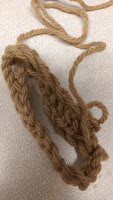http://www.metmuseum.org/exhibitions/listings/2015/fashion-and-virtue.
The main focus of the exhibit is the Met's collection of pattern books published during this time, supported by clothing, embroidery, paintings and other works of art of the time period.
I'm also going to look for this sculpture:
Master Heinrich of Constance (German, active in Constance, ca. 1300). The Visitation, ca. 1310–20. Walnut, paint, gilding, rock-crystal cabochons inset in gilt-silver mounts. The Metropolitan Museum of Art, New York, Gift of J. Pierpont Morgan, 1917 (17.190.724).
This is about 120 years past my main Period, but totally within the realm of my research. I'm most curious about the difference in the veils.
Why the difference in headpieces?
· Mary (on left) seems to have a decorative cord? chain? That is attached to veil, but how does the veil stay on? Perhaps the chain clips onto both the veil and Mary’s hair?
· Elizabeth (on right) seems to have a more traditional headband, decorated with embroidery?, and chin strap to which the veil would have been pinned.
Was the difference a part of perceived difference in rank between the two?
· Religious status: with Mary being more important because she was considered the Mother of God.
· Societal status: With Elizabeth being the higher rank because she was married to a priest, while Mary was pregnant and unwed.
To me the chin strap would make the veil more secure and therefore be used by someone who works. The lack of a chin strap for Mary indicates that the sculptor believes Mary to be of higher rank, someone who leads a sedentary, non-demanding life, as benefits the mother of our savior.
This belief of the sculptor, if I am interpreting this correctly, is of course completely contrary to the Bible. In the Bible, Mary is betrothed to Joseph (Luke 1:27), who was a carpenter, a manual laborer. Prior to the event portrayed here, Mary had just traveled to visit Elizabeth (Luke 1:39-43). It’s a good bet she walked there, on foot, without the aid of a donkey.
I'll be lining my cloak so I can display it at the East Kingdom 12th Night A&S Display/Popular Choice Competition. That's all that's new in the world of sewing at this time.
~ Marjorie















 Jenny making her caterpillar. She's excited about having something to do while recovering from ankle surgery.
Jenny making her caterpillar. She's excited about having something to do while recovering from ankle surgery.












